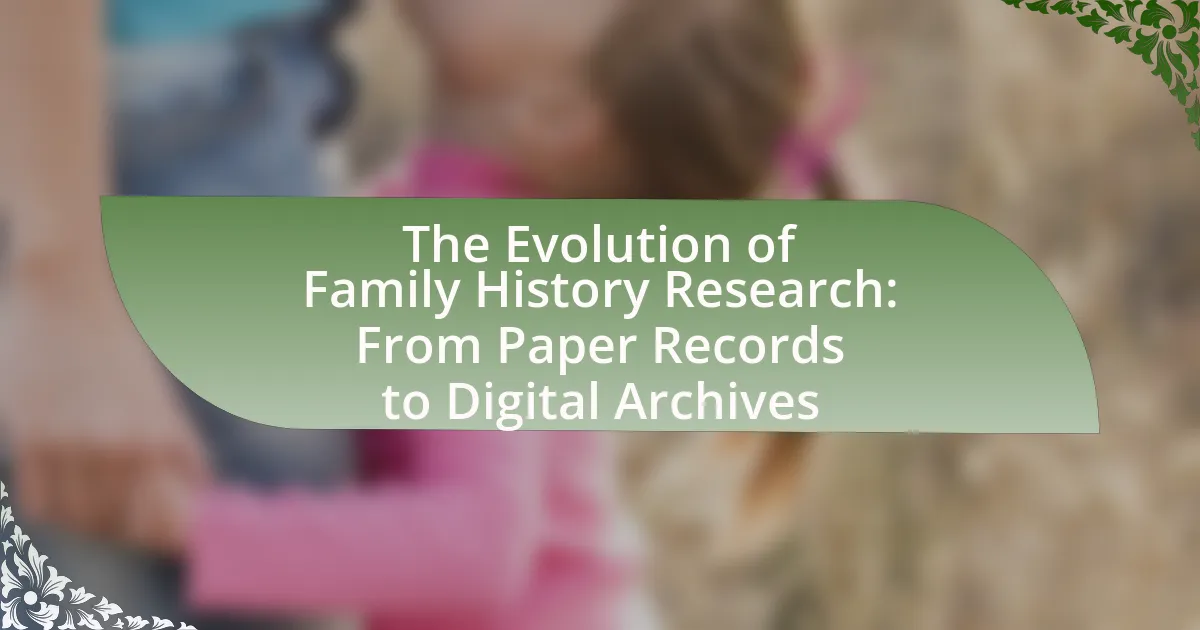Military records play a crucial role in genealogy research by providing detailed information about an individual’s military service, including enlistment, discharge, and engagements. These records encompass various types, such as service records, pension files, and draft registrations, which help genealogists trace family histories and understand their ancestors’ military backgrounds. The article explores the significance of military records, the types of information they contain, and how they contribute to understanding family history. It also addresses challenges in accessing these records, strategies for overcoming obstacles, and best practices for utilizing military records effectively in genealogical research.
What are Military Records in Genealogy Research?
Military records in genealogy research are official documents that provide information about an individual’s military service, including enlistment, discharge, and any engagements or battles participated in. These records can include service records, pension files, draft registrations, and unit histories, which collectively help genealogists trace family histories and understand the military background of ancestors. For example, the National Archives in the United States holds extensive military records that can reveal details such as rank, service dates, and personal information about soldiers, thereby offering valuable insights into family lineage and historical context.
Why are Military Records important for genealogical research?
Military records are important for genealogical research because they provide detailed information about an individual’s service, including personal details such as name, rank, unit, and dates of service. These records often include additional context, such as enlistment and discharge dates, which can help establish timelines in a family history. Furthermore, military records may contain information about family relationships, such as dependents or next of kin, which can aid in connecting individuals within a family tree. The National Archives and Records Administration (NARA) holds extensive military records, including service records, pension files, and draft registration cards, which are valuable resources for genealogists seeking to trace their ancestry.
What types of information can be found in Military Records?
Military records contain various types of information, including service details, personal information, and medical history. Specifically, these records often include a soldier’s name, rank, unit, dates of service, and discharge status. Additionally, they may provide insights into a service member’s battles, awards, and commendations, as well as personal details such as birth date, place of birth, and family information. Medical records within military files can reveal health conditions and injuries sustained during service. This comprehensive data is crucial for genealogical research, as it helps individuals trace their ancestry and understand their family’s military history.
How do Military Records contribute to understanding family history?
Military records significantly contribute to understanding family history by providing detailed information about an individual’s service, including enlistment dates, ranks, units, and personal details such as birthplaces and family relationships. These records often reveal connections to specific historical events, battles, or conflicts, which can contextualize a family’s experiences during those times. For instance, the U.S. National Archives holds extensive military service records that can help genealogists trace ancestors’ military involvement, thereby enriching the family narrative with insights into their sacrifices and contributions to national history.
What are the different types of Military Records available?
The different types of military records available include service records, pension records, enlistment records, discharge records, and casualty records. Service records document an individual’s military history, including assignments and promotions. Pension records provide information about veterans’ benefits and eligibility. Enlistment records detail the terms of service and personal information at the time of joining. Discharge records indicate the conditions under which a service member left the military. Casualty records track individuals who were killed, wounded, or missing in action. These records are essential for genealogical research, as they help trace family histories and understand military service contributions.
What is the significance of service records in genealogy?
Service records are significant in genealogy as they provide detailed information about an individual’s military service, including enlistment dates, ranks, units, and discharge information. These records can help genealogists trace family histories, establish connections to specific historical events, and understand the roles ancestors played in military conflicts. For instance, service records often include personal details such as birth dates and places, which can aid in constructing family trees. Additionally, they may reveal participation in significant battles or campaigns, thereby enriching the narrative of a family’s history and heritage.
How do pension records aid in genealogical research?
Pension records significantly aid in genealogical research by providing detailed information about individuals who served in the military, including their service history, family relationships, and personal details. These records often contain names of spouses, children, and other relatives, which can help researchers trace family lineages and establish connections between generations. For example, the U.S. National Archives holds pension files that can reveal a soldier’s enlistment and discharge dates, unit assignments, and even physical descriptions, all of which contribute to a more comprehensive understanding of an ancestor’s life and family dynamics.
What role do draft records play in tracing ancestry?
Draft records serve a crucial role in tracing ancestry by providing detailed information about individuals who were registered for military service. These records often include personal details such as names, ages, addresses, and physical descriptions, which can help genealogists establish family connections and verify lineage. For example, the Selective Service System in the United States maintained draft records during both World Wars, which are now accessible for research and can reveal insights into an ancestor’s life, including their socio-economic status and geographic movements. This information is invaluable for constructing family trees and understanding historical contexts surrounding an ancestor’s experiences.
How can one access Military Records for genealogy?
To access military records for genealogy, individuals can utilize resources such as the National Archives, which houses a vast collection of military service records, pension files, and other related documents. These records are often available online through the National Archives Catalog or can be requested in person or via mail. Additionally, websites like Ancestry.com and Fold3 provide digitized military records and can be accessed through subscriptions or library partnerships. The availability of these records is crucial for tracing family history, as they often contain valuable information such as service dates, unit assignments, and personal details about service members.
What are the best online resources for finding Military Records?
The best online resources for finding military records include the National Archives, Ancestry.com, and Fold3. The National Archives provides access to a vast collection of military service records, including enlistment and discharge documents, which are essential for genealogical research. Ancestry.com offers a comprehensive database of military records, including draft registrations and pension files, making it a valuable tool for family history research. Fold3 specializes in military records and provides access to documents such as service records, unit histories, and war-related documents, enhancing the research experience for those tracing military ancestors. These resources are widely recognized for their extensive collections and user-friendly interfaces, making them reliable for anyone seeking military records.
How can local archives and libraries assist in accessing Military Records?
Local archives and libraries assist in accessing military records by providing resources such as databases, physical records, and expert guidance. These institutions often house collections of military documents, including service records, pension files, and unit histories, which are essential for genealogical research. For example, the National Archives and Records Administration (NARA) offers access to military service records, and many local libraries have partnerships with NARA to facilitate access to these records. Additionally, librarians and archivists can help researchers navigate these resources, ensuring they find relevant information efficiently.
What challenges are associated with using Military Records in genealogy?
Using military records in genealogy presents several challenges, including accessibility issues, incomplete records, and the complexity of military terminology. Accessibility can be hindered by restrictions on certain records due to privacy laws or the physical condition of documents, which may limit researchers’ ability to obtain necessary information. Incomplete records often arise from loss or destruction during conflicts, such as the 1973 fire at the National Personnel Records Center, which destroyed many Army records. Additionally, the complexity of military terminology and acronyms can create confusion, making it difficult for genealogists to interpret the information accurately. These factors collectively complicate the process of utilizing military records for genealogical research.
What common issues arise when researching Military Records?
Common issues that arise when researching military records include incomplete or damaged records, difficulty in accessing records due to privacy laws, and variations in record-keeping practices across different branches of the military. Incomplete or damaged records can result from events such as the 1973 National Personnel Records Center fire, which destroyed a significant number of Army and Air Force records. Privacy laws can restrict access to certain records, particularly for veterans who are still living, complicating the research process. Additionally, variations in record-keeping practices can lead to inconsistencies in the information available, making it challenging for researchers to obtain a comprehensive understanding of an individual’s military service.
How can incomplete or damaged records affect research?
Incomplete or damaged records can significantly hinder research by leading to gaps in information and misinterpretations of data. When records are missing or illegible, researchers may struggle to establish accurate timelines, relationships, or events, which are crucial for understanding genealogical connections. For instance, a study by the National Archives indicates that incomplete military service records can result in incorrect assumptions about a veteran’s service history, affecting both personal family narratives and broader historical analyses. This lack of clarity can ultimately compromise the integrity of genealogical research, making it difficult to draw reliable conclusions.
What are the limitations of Military Records in genealogical research?
Military records have several limitations in genealogical research, primarily due to incomplete documentation and accessibility issues. Many military records were lost or destroyed in events such as the 1973 National Personnel Records Center fire, which resulted in the loss of approximately 16 to 18 million official military personnel files. Additionally, records may not include comprehensive details about all service members, especially those who served in smaller conflicts or were not formally enlisted. Privacy laws also restrict access to certain records, particularly for veterans who are still living, limiting the information available to researchers. Furthermore, military records often lack personal details such as birthplaces or family connections, making it challenging to establish a complete family history.
How can researchers overcome challenges in accessing Military Records?
Researchers can overcome challenges in accessing military records by utilizing online databases, engaging with veteran organizations, and understanding the specific archival processes. Online databases, such as the National Archives and Records Administration, provide digitized military records that can be accessed remotely, reducing the need for physical visits. Engaging with veteran organizations can offer guidance and support in navigating the complexities of military records, as these organizations often have resources and expertise in this area. Additionally, understanding the archival processes, including the types of records available and the necessary forms for requests, can streamline access. For instance, the National Archives has specific guidelines for requesting records, which can help researchers efficiently obtain the information they need.
What strategies can be employed to locate missing records?
To locate missing military records, researchers can employ strategies such as utilizing online databases, contacting military archives, and engaging with veteran organizations. Online databases like the National Archives and Ancestry.com provide access to digitized military records, which can help identify missing documents. Additionally, contacting military archives, such as the National Personnel Records Center, can yield information on how to request specific records or replacements. Engaging with veteran organizations can also provide leads, as these groups often have resources and networks that assist in locating records. These strategies are effective as they leverage existing resources and networks dedicated to military genealogy research.
How can collaboration with other researchers enhance findings?
Collaboration with other researchers can enhance findings by pooling diverse expertise and resources, leading to more comprehensive analyses. When researchers work together, they can share unique insights, methodologies, and data sources that may not be accessible individually. For instance, a study published in the Journal of Historical Research demonstrated that collaborative efforts in genealogy research resulted in the discovery of previously overlooked military records, significantly enriching the historical context of family histories. This collective approach not only accelerates the research process but also increases the accuracy and depth of the findings, as evidenced by the enhanced genealogical narratives produced through such partnerships.
What are best practices for utilizing Military Records in genealogy research?
Best practices for utilizing military records in genealogy research include identifying the specific military branch and time period relevant to your ancestor, as different branches maintain distinct records. Start by accessing the National Archives or equivalent repositories, which house service records, pension files, and enlistment documents. Utilize online databases such as Ancestry.com or Fold3, which provide digitized military records for easier access. Cross-reference military records with census data, birth and death certificates, and other genealogical documents to build a comprehensive family history. Additionally, consider joining military history or genealogy groups for shared resources and expertise. These practices enhance the accuracy and depth of genealogical research involving military records.
How should one organize and document findings from Military Records?
To organize and document findings from military records, one should create a systematic approach that includes categorizing records by individual, service branch, and time period. This method allows for easy retrieval and reference. Additionally, maintaining a digital or physical filing system with clearly labeled folders or binders enhances accessibility. Each document should be annotated with relevant details such as dates, locations, and relationships to other records, which aids in contextual understanding. Utilizing software tools designed for genealogy research can further streamline this process by allowing for the integration of notes, sources, and citations, ensuring that all findings are well-documented and verifiable.
What tools can assist in managing Military Record data?
Tools that can assist in managing Military Record data include specialized software such as Ancestry.com, Fold3, and FamilySearch. Ancestry.com provides access to a vast database of military records, allowing users to search and organize information efficiently. Fold3 focuses specifically on military records, offering features like document viewing and sharing, which aids in preserving and managing data. FamilySearch is a free resource that provides tools for tracking and organizing military records, making it easier for genealogists to compile comprehensive family histories. These tools are widely recognized for their effectiveness in managing and accessing military records, supporting genealogical research.
How can researchers ensure accuracy in their genealogical conclusions?
Researchers can ensure accuracy in their genealogical conclusions by meticulously verifying sources and cross-referencing information. This involves examining primary documents such as military records, census data, and birth or death certificates, which provide direct evidence of lineage. For instance, military records often contain detailed personal information, including service dates and family connections, which can be corroborated with other historical documents. Additionally, researchers should utilize reputable databases and archives, ensuring that the information is sourced from credible institutions. By employing these methods, researchers can substantiate their findings and enhance the reliability of their genealogical conclusions.
What tips can enhance the effectiveness of Military Records research?
To enhance the effectiveness of Military Records research, individuals should start by clearly defining their research goals, such as identifying specific ancestors or military service details. This focused approach allows researchers to narrow down the vast array of available records. Utilizing multiple sources, including the National Archives, state archives, and online databases like Ancestry or Fold3, increases the likelihood of finding relevant documents. Additionally, understanding the historical context of the military conflicts and the types of records generated during those times, such as enlistment papers, discharge records, and pension files, can provide valuable insights. Cross-referencing information from different records helps verify accuracy and fill in gaps. Engaging with military history forums or genealogy groups can also provide tips and resources from experienced researchers.
How can networking with genealogy groups improve research outcomes?
Networking with genealogy groups can significantly enhance research outcomes by providing access to shared knowledge, resources, and expertise. Engaging with these groups allows individuals to exchange information about military records, which can be complex and varied. For instance, members often share tips on navigating archives, databases, and specific military documentation that may not be widely known. Additionally, collaboration can lead to the discovery of previously unknown relatives or connections, as many members may have overlapping research interests or family histories. This collective effort can result in more comprehensive and accurate genealogical research, as evidenced by numerous case studies where individuals have successfully traced their lineage through collaborative efforts in genealogy forums and local societies.
What are the benefits of attending workshops or seminars on Military Records?
Attending workshops or seminars on Military Records provides valuable insights into the complexities of military documentation and its relevance in genealogy research. Participants gain access to expert knowledge, which enhances their understanding of how to effectively locate, interpret, and utilize military records for family history purposes. Additionally, these events often offer networking opportunities with other researchers and professionals, fostering collaboration and the sharing of resources. Evidence shows that individuals who engage in such educational settings are more likely to successfully trace their military ancestry, as they learn about specific databases, archival resources, and methodologies tailored to military records.




